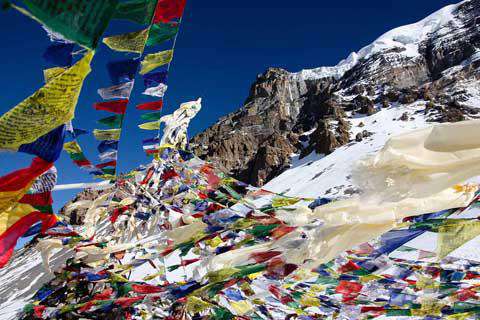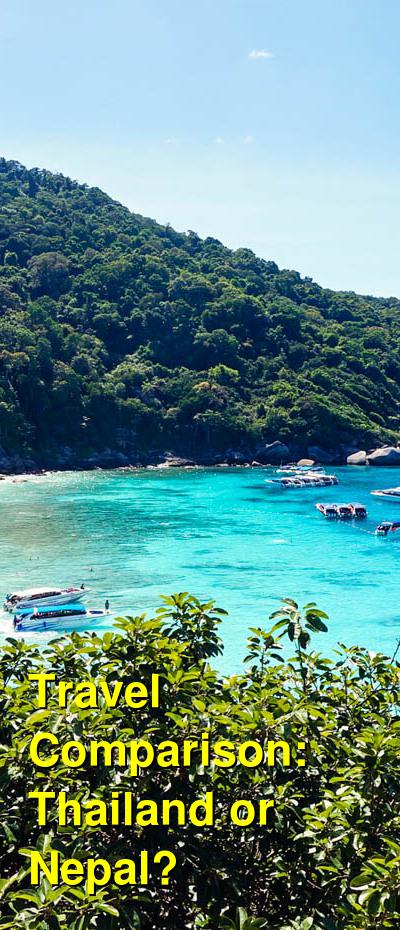Should you visit Thailand or Nepal?
Thailand and Nepal are both budget-friendly travel destinations with plenty of amentities for backpackers and budget travelers. But that's where the similarity ends, because Thailand is all about the beaches and the jungle, while Nepal is known for world-class trekking through the Himalayas.
Thailand is the most popular country to visit in Southeast Asia, and its economic dependence on tourism can be felt in even the smallest and most remote parts of the country. The beauty of Thailand is quite evident, and the diversity of landscapes, combined with the generally friendly nature of its people lead to a huge number of tourists every year. But all of these visitors can drive prices up a bit. Bartering is a must in Thailand where the tourist prices are dramatically higher than local prices.
Nepal is a mountainous country that covers much of the Himalayas. In fact, this is the main reason why visitors come to this beautiful country. With expectations of hiking and climbing the worlds tallest mountains, visitors to Nepal usually find much more: a friendly culture full of history, religion, music, and great food. These cultural attractions often keep travelers in the country for longer periods of time than their initial plans, as after trekking the mountains, everyone agrees that Nepal has so much more to see than just Everest or the Annapurna Circuit.
Which country is cheaper, Nepal or Thailand?
Should I visit Thailand or Nepal? This is a popular question for many travelers. By figuring out which country is more expensive, you'll understand where you'll get more bang for your buck. A week in Nepal can cost you about $278 (per person), while a week in Thailand may cost you around $572. These differences become even more noticable if you plan to spend a longer time in the country. 10 days, two weeks, or even one month of travel to Nepal or Thailand can really add to your travel budget.
Accommodation is often cheaper in Nepal compared to Thailand ($17 vs. $35). Budget travelers usually stay in less expensive hostels and guest houses, while nicer hotels often appeal to families and upscale travelers.
Compare hotel prices here: Thailand Hotel Prices and Nepal Hotel Prices.
Or, compare hostel and guesthouse prices between Nepal and Thailand to find the cheapest accommodation here: Nepal hostels and Thailand hostels.
When comparing food in Thailand vs. Nepal they are not just different in cuisine, but also in price. Meal and restaurant costs in Thailand ($17) are often cheaper than Nepal ($8.46).
When is the best time to visit Thailand and Nepal?
 Longtail boats around Koh Phi Phi, Thailand
Longtail boats around Koh Phi Phi, Thailand
The high season for travel in Thailand is between November and February, although visitors come all year. The seasons are caused by monsoon winds more than temperature changes, though. In the north, the dry season is between November and May. The southern coasts stay relatively dry during this time as well. Due to a change in weather patterns, the east and west coasts receive rainfall at different times of the year. The wettest time on the western coast is usually between April and October, while the east coast experiences more rain between September and December.
Trekking and hiking is best in Nepal (and the Himalayas in general) in the spring and fall. At these times, the winter snows are gone but the summer rains won't ruin your trip. At these times, the air is clear and crisp, and quite warm at lower altitudes and mild up in the mountains.
Expect other trekkers to be in the mountains at these times, however. Since it is considered dangerous to trek at other times of the year, the vast majority of visitors come at this time, raising prices and filling hotels and guesthouses.
Why is Thailand more expensive than Nepal?
Thailand's economy is strongly dependent on tourism. Thailand has a numerous bus and other transportation companies in place that cater specifically to backpackers and mid-range travelers. These services are significantly more expensive than the public government-run transportation system that locals use. (However, they are not always more efficient.)
Touristy areas in Thailand are expensive simply due to supply and demand. On many islands, land is limited and therefore accommodation options are not as numerous as the number of tourists needing beds. Also, many of the islands need to have food, fuel, and supplies shipped in, leading to a higher cost of food at restaurants, higher taxi prices, and an increase in the price of souvenirs, clothing, etc.
Nepal has a very low overall cost of living compared to most countries in the world, or even most countries in Asia. Tourism and agriculture are two very important industries, leaving low wages and high competition for income, especially from tourists. Plenty of small, family-run hotels and restaurants, as well as other tour services, are available leading to a large amount of competition. It's even possible to find trekking guides by just walking down the street in Kathmandu or Pokhara, as the local people are often looking for extra work.
What are the most expensive and cheapest cities and regions in Thailand and Nepal?
 Thorong La Pass, Annapurna Circuit, Nepal
Thorong La Pass, Annapurna Circuit, Nepal
As a general rule in Thailand, the more touristy a destination, the more expensive it is. Southern Thailand is more expensive than northern Thailand with some of the most expensive areas being the islands of Phuket, Koh Phi Phi, Koh Samui, and Koh Phangan. The time of year can also dramatically effect cost. During the Full Moon Party, prices in Koh Phangan can climb, but expenses are more reasonable during slower times.
Visitors to the larger cities of both countries can experience a mix of prices. With a more diverse range of options, travelers to Bangkok, Kathmandu, Pokhara, Chiang Mai, Pattaya, and other urban areas can find both cheap and expensive accommodation and food options. More luxurious accommodation is available at higher prices, for those that desire it. However plenty of budget options are around for anyone looking for a cheap place to stay or a cheap place to eat. Those on a shoestring budget can stay in the cities for long periods of time spending just a little bit of money per day.
In the countryside of northern Thailand, prices tend to be cheap. Smaller towns in the north wish to attract visitors and lower their prices accordingly. However, sometimes transportation can get pricey. In the countryside of the lowlands of Nepal, the same is generally true. However, the higher up in the mountains you go, the higher prices go as well.
Trekking in Nepal, while not overly expensive, can cost significantly more than staying in the larger cities. This is because much of the food and other goods needed in the mountains must be transported up by locals. At higher elevations, for example, food is not as readily available, and therefore costs more. And villages at higher elevations are less frequent and less populated, leading to less guesthouses (or "tea houses") to sleep in, driving up costs even more.
Royal Chitwan National Park can also see higher prices due to the remote nature of many accommodation options and the overall demand for visitors.
How you can save money when visiting Thailand and Nepal?
Negotiate hard! This is particularly true in Thailand as well as other Asian nations. Negotiating in Nepal is often necessary, but not as challenging.
Go off the beaten path. Prices in touristy areas tend to be the highest.
Travel with the locals. Find local transportation (the government buses) whenever possible and avoid paying a premium for tourist or "VIP" buses. Often, the government bus station will be in the center of town or separated from the tourist areas.
Slow down. If you're rushing through the area you're going to spend more money. Transportation costs can be somewhat expensive, so the more places you visit, the more money you're going to spend.
Plan your trip schedule carefully. Festivals are fun but expensive. If going to the Full Moon Party isn't your priority, avoid the island areas during these times. Also look at the holiday schedule to see when locals are on vacation.
Saving money in Nepal is quite easy. Shop around for everything and settle on a place (hotel, restaurant, or shop) that you find to be of acceptable quality for your budget. This is very easy to do in cities and towns.
While in Kathmandu, shop carefully for trekking gear. Some shops sell the real thing, while others sell knock-offs. Sometimes the knockoffs are actually the real thing, but they are just damaged and couldn't be sold abroad, making them a great buy. Other knock-offs are of poor quality and made by locals looking to make a quick buck. Either way, good deals can be found everywhere.
If the idea of a separate guide and a porter or two for your trek in Nepal seems too expensive, it is often possible to hire a "porter-guide" instead. These are usually younger men who will carry your bag as well as act as a guide. They are more expensive than a porter, but cheaper than a guide, and they will speak English to help you along your route. Expect them to be not as experienced as the higher-end guides, however.


 Budget Your Trip is all about finding out how much everything costs so that you can travel cheaper and longer. Created by avid travelers Laurie and Bryan, our goal is to help you plan your next trip on the right budget. With average daily travel costs that are calculated from the budgets of real travelers, plus an analysis of hotel and tour prices, you can find out how much money you need to plan your next adventure. We also have plenty of travel advice, accommodation reviews, and activity suggestions.
Budget Your Trip is all about finding out how much everything costs so that you can travel cheaper and longer. Created by avid travelers Laurie and Bryan, our goal is to help you plan your next trip on the right budget. With average daily travel costs that are calculated from the budgets of real travelers, plus an analysis of hotel and tour prices, you can find out how much money you need to plan your next adventure. We also have plenty of travel advice, accommodation reviews, and activity suggestions.
